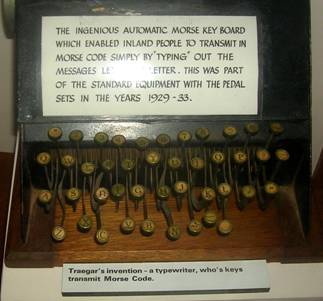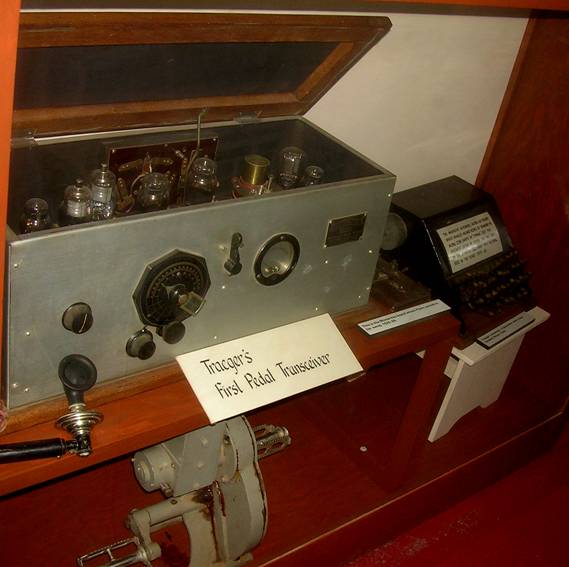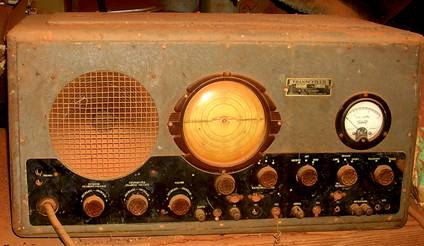
South Australian Medical Heritage Society Inc
Website for the Virtual Museum
Home
Coming meetings
Past meetings
About the Society
Main Galleries
Medicine
Surgery
Anaesthesia
X-rays
Hospitals,other organisations
Individuals of note
Small Galleries
Ethnic medicine
- Aboriginal
- Chinese
- Mediterran
The story of the Flying Doctor Radio
Alfred Herman Traeger and his transceivers
The plan for the Flying Doctor Service was conceived in 1912 by the Rev. John Flynn , superintendent of the Australian Inland Mission of the Presbyterian Church, became practical when an Adelaide electrical engineer, A.H. Traeger, developed a low-powered, portable, pedal-driven, Morse radio transmitter-receiver with a range of 300 miles. This transceiver, together with the use of aeroplanes, made possible a system of regular long-distance medical consultations and the flying of doctors to patients in emergencies.

Traeger Avenue in Alice Springs, named after Alfred Traeger
.

Mr. Athol Blyton outside Traeger’s workshop, standing next to the original dessert oak antenna pole, Adelaide House, Alice Springs.
.
Acknowledgements: The help, comments, hospitality and access to photograph the various transceivers is much appreciated.
The Twins Station: Mr. Wayne Rankin and his wife Sharon.
Alice Springs : Laurel and Dr. Charles Butcher.
Adelaide House Museum : Athol Blyton.
Molly Clarke: Past pedal radio operator, Andado Station.
Royal Flying Doctor Service:
Mr. Grant Whan. School of The Air.
Jen Davies. Port Augusta : RFDS Station:
Mr. Phil Morgan. Boolarong press ISBN: 0 46349 1972 7, “Traeger the pedal radio man”.Alfred Herman Traeger was born into a Balaclava family on 2.8.1895. At the age of 12 he constructed a telephone link between the house and a near by tool shed. Years later he obtained a diploma in electrical engineering from the “Adelaide School of Mines”. After several posts he was offered a position as an electrical mechanic at the Hannan Brothers garage in Wakefield Street .
It was here he met John Flynn for the first time I June 1925 and sold him a 600 volt generator for £29.10s. a power source for Flynn’s early radios. Flynn returned to Adelaide a year later and engaged Traeger’s help in the promotion of radio communications in the Outback. At this time camel trains, horses, and Flynn’s “Dodge” buckboard car were used for transport in these remote areas.
In November 1926 Traeger and Flynn traveled to Hermansberg Mission and established radio contact with Adelaide using copper oxide batteries to power the filaments and a 32 volt generator, for the plates. Contact with Alice Springs occurred later, due to an incorrect coil being inserted there so they were trying to receive on the wrong frequency. Eventually the test was a success and Traeger was appointed Radio Engineer for the Australian Inland Mission. This involved travel to Cloncurry and many other areas to develop radio communications.
Diagram of a copper oxide cell
Two connected in series provided the valve filament power. & a diagram of a simple (triode) radio valve.
The signal from the microphone or antenna is connected to the grid which modifies the electron flow from the heated filament to the positively charged plate,
This amplified current is fed to the speaker or the transmitting antenna. The bicycle generator provided the power to the plate.


While towns and stations with generators could provide the electricity to provide power for Traeger’s radio transceivers, smaller homesteads had an urgent need for a power source. Hand driven generators were introduced first but required 2 operators for the radio.

A copy of the photograph taken by Flynn of Traeger in 1928 demonstrating the first pedal radio, He is operating a morse key
Traeger was keen on using bicycle pedals and on the 17th November 1928 the famous pedal generator, which produced 180 volts DC for the valve plates, was unveiled in Adelaide, and Flynn took the famous photograph.
Traeger also developed a unique typewriter which converted letters into Morse code. This was a boon to the Morse-challenged settlers. These transceivers could receive the reply by voice telephony transmitted by the more powerful base stations. Improved sets followed
The survivors of that era speak in glowing terms of the Traeger radio sets and the pedal generators. The frequently used phase is “Traeger opened up the Outback” Contact with the Royal Flying Doctor Service was routine, and many lives were saved. The School of the Air provided education. It became common to switch the set on in the morning and “listen in”. Problems were solved and advice given. Later arrival of telephone sets and direct private communication was therefore not popular. However the recent popularity of “Outback” travel and exploration, has resulted in the fitting of Flying Doctor mobile radios in private 4wds. Which may be used outside the coverage of the mobile net.
Traeger Telephony Transceiver 1936 -1940

The first is of interest, (1936-1940) as it was the first set capable of transmitting telephony, avoiding the difficult Morse code, and allowing two-way conversation. It is a 158 V4 3.6 manufactured under license from Phillips Electrical Industries Pty. Ltd.
.
.
.
.
.

The second set preserved at Twin Station, a Traeger 1401 54 s 20, was one of the first to use a vibrator, transformer, and rectifier, to obtain the high voltage anode voltage from a 6 volt lead acid accumulator, which also supplied the 6.volts for the valve filaments.
It was introduced in 1943, and operated in two-way telephony with no Morse.
.

Next: Two Traeger Flying Doctor transceivers preserved at the Twin Station.
..

.

Mr Wayne Rankin of Twin Station with a Traeger Vibrator Radio

Early Traeger transceiver late 1920s enclosed in a wood box with Morse key, and Morse typewriter. preserved at the RFDS at Alice Springs
Traeger’s invention, the Morse typewriter

Pressing letter keys activated strips of metal contain-ing notches and indentations representing the dots and dashes of the Morse code:
.

List of drugs and other pharmaceuticals identified by numbers supplied to outlying stations. It was to be kept next to the transceiver

Molly Clarke: Trained as a nurse at Wakefield Street Hospital in Adelaide in 1940. Later because of pulmonary problems she became governess for the “Oldfields” After marriage she and her husband managed several stations. Finally after Lake Harry they finished at Andado station.She was a respected pedal radio operator. She believed in slow steady pedaling, admired Flynn for introducing voice communication, and believed that this opened up the outback.

Camels were often used as beasts of burden. The planks were used for balance, and the boat was used in the wet season, and earlier in the search for the inland sea.

Some medicines found in the cellar of Adelaide House, Alice Springs

Pedal radio generator preserved at Adelaide House, Alice Springs
 Diesel or petrol driven generators provided power for the transceivers in larger centers, Homesteads used the pedal generator (foreground).
Diesel or petrol driven generators provided power for the transceivers in larger centers, Homesteads used the pedal generator (foreground).

.
Traeger pedal generator preserved in RFDS Museum Alice Springs

Well preserved example of an early Traeger transceiver in the Alice Springs RDFS Museum with Morse key and Morse typewriter.

Later model of Traeger transceiver TS3 capable of 2 way telephony


A Vaughan RFDS transciever VSR F8 probably single side band, which was introduced world wide in the 1970s.
Traeger was unable to supply sufficent SSB transceivers to replace all the now obsolete RFDS radios.

Other companies entered the field later.
The photograph shows an “EILCO” (electronic instruments lighting company). It was a portable 5 channel transceiver. Light and compact. The microphone, batteries and antenna fitted into a compartment on the left of the apparatus.

Early Traeger transceiver preserved at the Port Augusta RFDS

School of the Air
Photograph of a teacher & pupil. Port Augusta RFDS

Currently used equipment at the Port Augusta RFDS radio base.

A modern single sideband RFDS frequency transistorised 50 watt transceiver installed in the top left hand of a 4 WD central console.
Note change in size compared with valve radios . The speaker is fitted just to the left of the steering wheel. The radio top right is a citizens band UHF transceiver.
.-o0o-